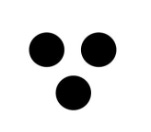We humans look out on the world from the perch of these chunks of flesh called human bodies, and this vantage point colors our vision. We tend to see ourselves in everything around us - even in non-living things. People see faces in the moon, and arms in the branches of a tree. It’s almost as if we are instinctually yearning to find and meet other humans, and so we tend to “see” them everywhere we look.
Even young infants recognize human faces. Studies show babies respond to 3 dots in the shape of eyes and a nose differently than they respond to 3 dots in any other configuration.
There was even a study of this sort with unborn babies in the womb: Researchers shined bright light with various 3-dot configurations through the mothers’ abdomens (surprisingly, the abdominal wall and uterus are not completely opaque). After counting the number of times the babies turned their heads toward the images (the researchers could see this movement with ultrasound), they found that the unborn test subjects turned towards the 3 dots resembling a human face significantly more often than they did toward other configurations.
Perhaps this is the same tendency that is worked into human language: we describe the non-human world around us using words from our own bodies. I call these “anatomical metaphors.” For instance, we talk about bottlenecks, because this portion of a bottle really does look like where human shoulders narrow into the neck. In the same metaphorical way, we say things like: the legs of a table, the foot of the bed, and the face of a clock. (Clocks used to have hands too in the bygone analog world). More examples: the mouth of a river and the butt of a joke.
Some anatomical metaphors are verbs: to rib someone means to tease them, and you know what necking means. Some are adjectives: cheeky means amusingly irreverent and nosy means poking into other people’s business.
My two all-time favorites: the shoulder of the road and the spine of a book.
There are so many other anatomical metaphors littering every human language. Which ones are your favorite? And do you know of any others in languages besides English?





The leader or director an organization is referred to as the 'head'. This is true in Hebrew (Rosh) and Arabic (Rais) and probably other languages.
Yeah there is a human tendency for knowing more people and interacting with them more. I guess therefore such and such civilizations were built and changed map of the world. But sadly enough whenever I talk with someone who really likes exploring nature and animal kingdom, they tend to say: "I don't like being around people or I like when there is no one around." But he forgets people are also part of this magnificent nature and deep down everybody wants someone who can stand with them. Yes I speak Uzbek, Russian and little Arabic and every these languages use kinda same expressions with human body and things around them.